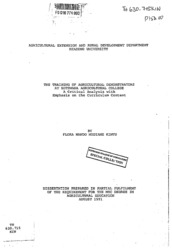| dc.description.abstract | The majority of people in Botswana depend on agriculture for their livelihood. Through extension, the development programmes providing farmers with inputs and information on the latest farming techniques to improve productivity. The Agricultural Demonstrators (AD's), trained mostly in neighbouring countries, provided the link between the government and the farmer. The first institution for training extension workers, Mahalapye Agricultural Training Centre (MATC), was established in 1966 and thereafter the course transferred to Botswana Agricultural College (BAC). The college has since undergone a number of developments and changes. New training programmes have been introduced and additional facilities provided.
Lately senior officers in the Ministry of Agriculture and farmers have complained about the quality of training of the extension workers from BAC and provide the trainees with the right practical skills. This dissertation aims at evaluating the training of ADs at BAC to determine the basis of these concerns.
Chapter one discusses the importance of agriculture and its role in rural development in Botswana. I also discuss the physical environment of the country to highlight environmental conditions such as climate, which determine the success of a farming enterprise. Farming systems are also described to explain the farming patterns in the traditional and the commercial sectors.
Chapter two discusses the organization of extension in Botswana to explain the evolution of the approaches currently used. Chapter three outlines the stages in the designing of training programmes. An outline of activities at all stages (in the training cycle), identifying training needs, defining the target group, planning the training, designing the training, implementing the training and evaluation is provided. The description of the curriculum used in the training of AD's follows in chapter four; the elements in the curriculum are highlighted. The curriculum content is then analyzed in chapter five. Subject matter is checked for completeness and relevance to the work of the AD. Limitations of the curriculum such as coverage of irrelevant material and lack of use of varied teaching methods are discussed. Chapter six provides suggestions for improving the curriculum. A systematically developed curriculum is recommended. A model curriculum to demonstrate the curriculum process with the four essential elements is provided. In addition, some factors such as shortage of staff, training and staff motivation, which are related to content but are equally influential to the curriculum, are outlined. Suggestions for improving the training are then provided. | en_US |

